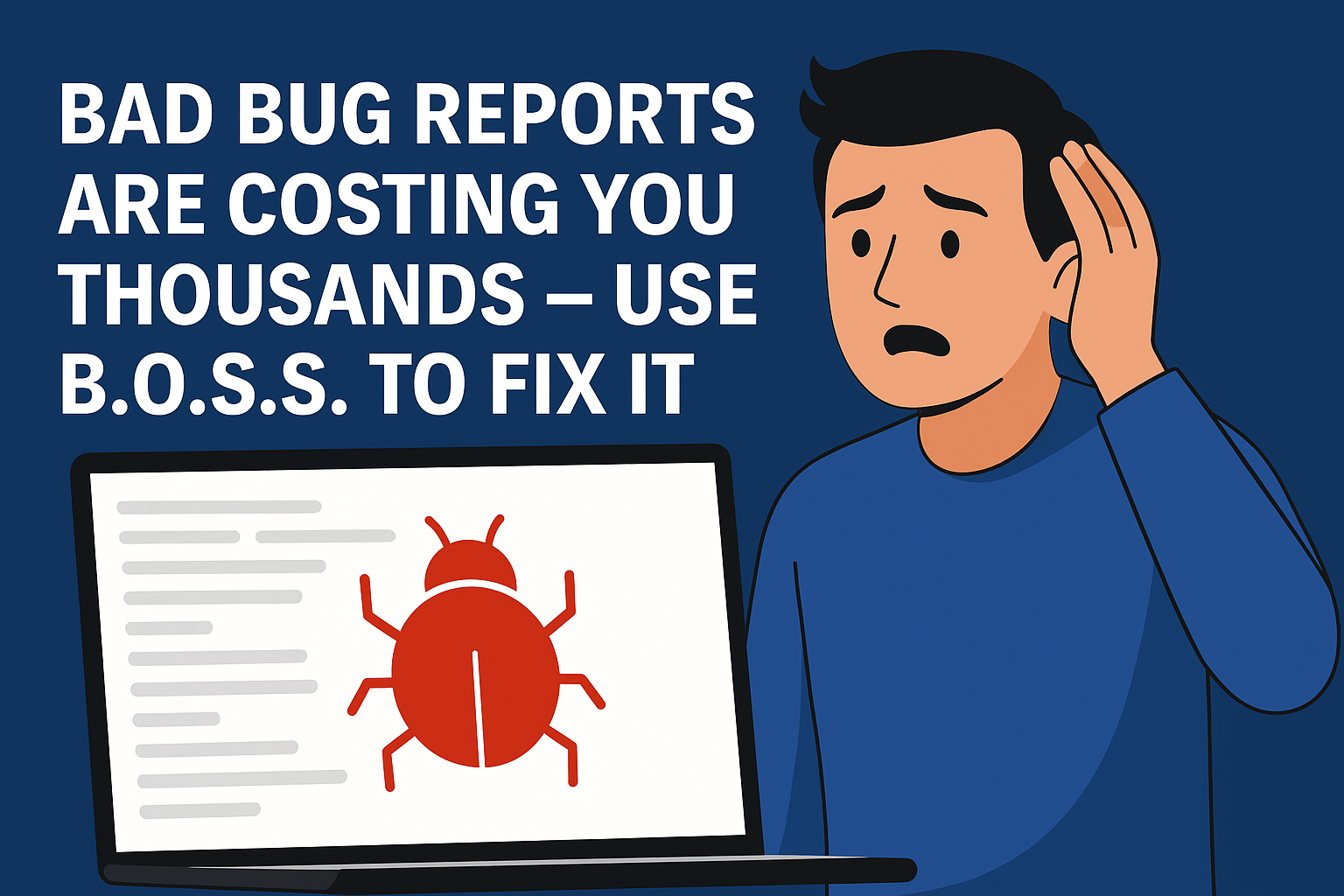Bad Bug Reports Are Costing You Thousands— Use B.O.S.S. to Fix It
Bad bug reports and status updates don’t just frustrate devs — they bleed time and money across teams. Learn how to structure them using the B.O.S.S. framework and save hours (and thousands) every week.

The Hidden Cost of a “Small” Bug Email
“Invoice PDF not downloading. Need urgent fix before client call.”
You’ve seen it before. You’ve probably written one like that yourself.
But here’s what you didn’t see:
- A QA wasted 2 hours trying to reproduce it with no success
- A developer scratched their head, reading the same line 10 times
- A manager escalated it, unsure whether it’s urgent or trivial
- Two meetings later, people are still confused
All that… because of a 5-word bug report.
Now imagine this happening 5 times a week.
Across 3 teams.
Across 6 months.
That one vague sentence?
It just cost your company thousands of dollars — in wasted time, delayed deliveries, and frustration.
🧩 The Bug Isn’t the Real Problem
Look — bugs are a part of software. You can’t eliminate them entirely.
But you can eliminate the chaos that follows a poorly written bug report.
Because what slows down teams isn’t just the bug.
It’s how the bug is reported.
A few words with no context can:
- Confuse your teammates
- Delay root cause analysis
- Trigger unnecessary escalations
- Waste hours of work
Multiply that across projects and teams, and you’re dealing with a hidden cost that no one is tracking — but everyone is paying for.
🤦♂️ Why Most Bug Reports Fail
Most developers and testers are trained to:
- Think logically
- Write good code
- Test rigorously
But no one teaches them how to write bug reports that are clear, actionable, and trust-building.
So what do you get?
- Bug titles like “Search not working”
- No reproduction steps
- No environment info
- No idea how severe it is
Worse — this becomes the default.
Everyone accepts it.
And the damage keeps happening silently.
💡 Enter the B.O.S.S. Framework
Here’s a simple way to level up your bug reporting game — without needing a course, training, or approval.
It’s called B.O.S.S. — a 4-step structure for writing impactful bug reports.
B — Bug Summary: What exactly is the problem? (1-line headline)
O — Observation: How did you observe it? (steps, env, app/browser details)
S — Suspected Impact: Who or what is affected? Business consequence?
S — Suggestion (optional): If you have a clue about the cause, mention it
That’s it.
No fluff.
Just structured clarity.
🔍 B.O.S.S. in Action
Let’s take a messy bug report and turn it around.
❌ Unstructured Bug Report
“Invoice PDF not downloading. Need urgent fix before client call.”
Not helpful. Time-wasting. Frustrating.
✅ B.O.S.S. Version
- Bug: Invoice PDF download fails on clicking the download button
- Observation: On staging, tried downloading invoice #INV-2025-2343 from Chrome (v116) – nothing happens. Console shows 500 error from
/download-pdfendpoint. - Suspected Impact: Impacts finance team and client billing — blockers for daily invoice reconciliation
- Suggestion: Might be a backend auth/session token issue — worked in the previous build
📌 With this version:
- QA knows exactly how to replicate
- Dev knows where to start
- PM understands how serious it is
This saves hours. Literally.
💰 How Much Does a Bad Report Actually Cost?
Let’s put real money to it.
- A dev wastes 2 hours decoding a vague bug = $25–$50 gone
- A QA tries wrong test cases = $40+ down the drain
- PM escalates or mis-prioritizes = $20–$30 of lost focus
Now multiply this across:
- 5 bugs/week
- 10 people
- 3 teams
- Over 3 months
You’re looking at thousands of dollars in hidden burn.
Just because bug reports weren’t structured.
🚀 How B.O.S.S. Helps Your Career Too
This isn’t just about helping your team. It’s a secret weapon for you too.
Great bug reports show:
- You think clearly
- You understand business impact
- You care about saving time for others
- You can write like a tech lead
People will start relying on you.
Your name will pop up in meetings.
You’ll be seen as someone who “gets it”.
And that visibility?
It compounds — in trust, influence, and eventually… in money.
🧠 Objection: “But I’m Not Paid to Write Emails”
True.
You’re not hired to be a writer.
But in real-world tech:
- Writing a bug report is part of delivering quality
- Writing it well is part of growing faster than your peers
The dev who clears confusion fast gets more trust.
The tester who documents precisely avoids blame.
The engineer who explains clearly gets promoted.
Structured writing ≠ extra work.
It’s high-leverage communication.
📌 Final Thought
Every bug report you write is either:
- A blocker: Vague, confusing, time-wasting
- Or a booster: Clear, helpful, progress-making
Choose to be the booster.
Start today:
- Use B.O.S.S. for your next bug report
- Observe how your team reacts
- Track how fast the issue gets resolved
Small shift. Big impact.
💬 Bonus Tip: Save This for Daily Use
Next time you write a bug report or update, follow this:
B — Bug summary
O — What did you observe and how
S — Who/what is impacted
S — Any guess about cause (if any)
You don’t need to be a writer.
You just need a structure.
💬 Let’s Connect
Enjoyed this article or have a perspective to share? Let’s connect on LinkedIn.

